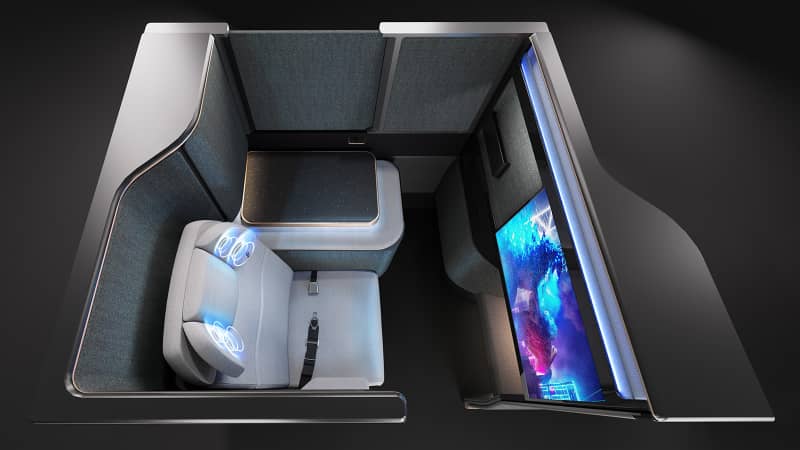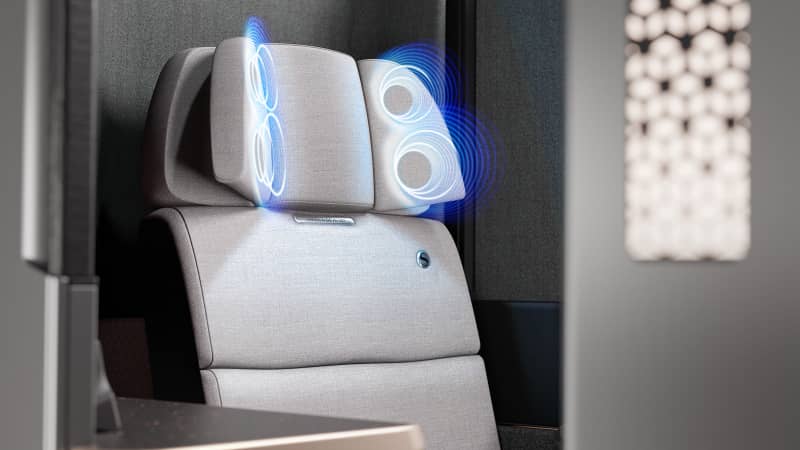Hamburg, Germany (CNN) — As wireless headphones become increasingly omnipresent, standard-issue airline headphones with their tangled cables and multi-pronged jack plugs seem increasingly outdated.
Sure, you can now link up personal headphones with some airplane inflight entertainment systems, but will your batteries last the length of a long-haul flight, and are you willing to risk losing your expensive earbud in the seat mechanism, never to be seen again?
Enter Euphony, a new airplane seat concept from French aircraft interior designer Safran Seats, produced in collaboration with audio technology company Devialet.
Euphony does away with the need for a personal headset. Instead, speakers are installed in each individual seat’s headrest, with sound levels perfected so passengers can enjoy their choice of inflight entertainment without being overheard or disturbed by their neighbor.
Comfortable set up

Euphony is designed for a business or first class cabin.
Safran
At first glance, the AIX prototype looks similar to a regular business class airplane seat. Safran has made only minor aesthetic adjustments to the headrest design.
But the difference is apparent as soon as the inflight entertainment is switched on. Sound starts blasting out of the headrest, droning out the pre-recorded airplane engine sounds already echoing through the experience room.
The screen plays the booming trailer for the recent Marvel movie “Doctor Strange in the Multiverse of Madness.” Atmospheric music blares through the headrest, before the system switches to a couple of different audio experiences, including a podcast, for comparison.
It takes me a little while to get the headrest in the perfect spot — for maximum sound quality, you want it to be as close to your ears as possible.
But once it’s in the right setting, the personal speakers seem to work well. The whirring of the simulated airplane engine becomes largely background noise and my attention focuses on what I’m seeing and hearing.
Euphony is no replacement for the cocoon-like experience of noise-canceling headphones, but it’s a comfortable set up and feels more akin to the experience of watching a movie on your couch. It would be perfect if you were flying with someone else and wanted to chat and interact as you watched a movie in tandem.
In the AIX experience room, it’s hard to judge whether or not there’s really no sound leakage — there’s only one Euphony mock-up in place. But the fact that you can’t properly hear the sound unless you’ve got the headrest next to your ear suggests it should be relatively leak-proof, at least in business or first class, where passengers are more spaced out.
Travelers looking for total noise cancellation or privacy may still wish to use their personal headset, but Safran senior architect Paul Wills and his team say the idea behind Euphony is to offer travelers more options. Travelers can also connect personal devices to the system via Bluetooth, and headrest speakers work when the seat is fully reclined as well as upright.
In-flight announcements wouldn’t be broadcast through the headrest, because they would also be broadcast in the cabin at large, and Wills’ team wants to avoid a “funny mish-mash of sounds.”
Instead, any announcements from the captain or cabin crew would just halt the inflight entertainment, as is already the norm on flights.
Complex design process

Safran partnered with audio experts Devialet to perfect the sound design.
Safran
Euphony has been in development for some years now, and Wills and his team say perfecting the concept took trial and teamwork.
When Safran first experimented with putting speakers into the headrest, before Devialet came on the scene, Wills says the sound quality was “awful.”
“At that point it was obvious that we’re good seat designers, but we’re not sound designers, so we had to find someone who was,” he says.
Franck Lebouchard, Devialet’s CEO, says the project was a “thrilling” challenge for his group of audio experts.
“An aircraft is probably the most complex sound environment you can imagine, both in terms of the frequencies — low frequencies, high frequencies — and the volume,” Lebouchard tells CNN Travel.
The difficulty in simultaneously blocking out the airplane’s low and high frequency sounds at any one time is what prompted the team to develop Euphony without noise cancellation technology — the designers wanted to avoid blocking out one frequency and unintentionally upping the other.
But Safran and Devialet say the current iteration of Euphony will adjust in real time to mask the cabin noise, and future iterations of the concept will look to further improve the sound mix.
Another challenge was ensuring the best sound quality possible, at the lowest weight. Airlines are always trying to avoid unnecessary extra load — both to reduce their carbon footprint and avoid extra costs.
The finished product still adds an extra kilo to any pre-existing seat, and it’s partly for this reason that Euphony is a business and first-class offering, at least for now.
“It may not be appropriate at the moment in economy, purely and simply because it weighs too much,” explains Wills.
But in the future, the team reckons they could fine tune the concept for lower cost cabins.
“There’s a clear demand for it,” says Wills.
Safran already has a yet-to-be-revealed partner launch airline, which will be premiering the product on their first class and business class cabins in early 2023. Euphony test flights will take place at the end of this year.
The ultimate aim, says Wills, is to make flying as “normal” as possible, replicating the experience of relaxing in your own home.
“When you go home, you don’t go and pop your headphones on for the evening and watch a movie — it just doesn’t work, does it? You can’t chat to your partner, or your friends, or shout at the dog or whatever else you need to do. You need to be free to move about. And that was the idea with this. You sit down, turn on the TV, play a movie — it’s just like home.”
Top photo courtesy Safran
